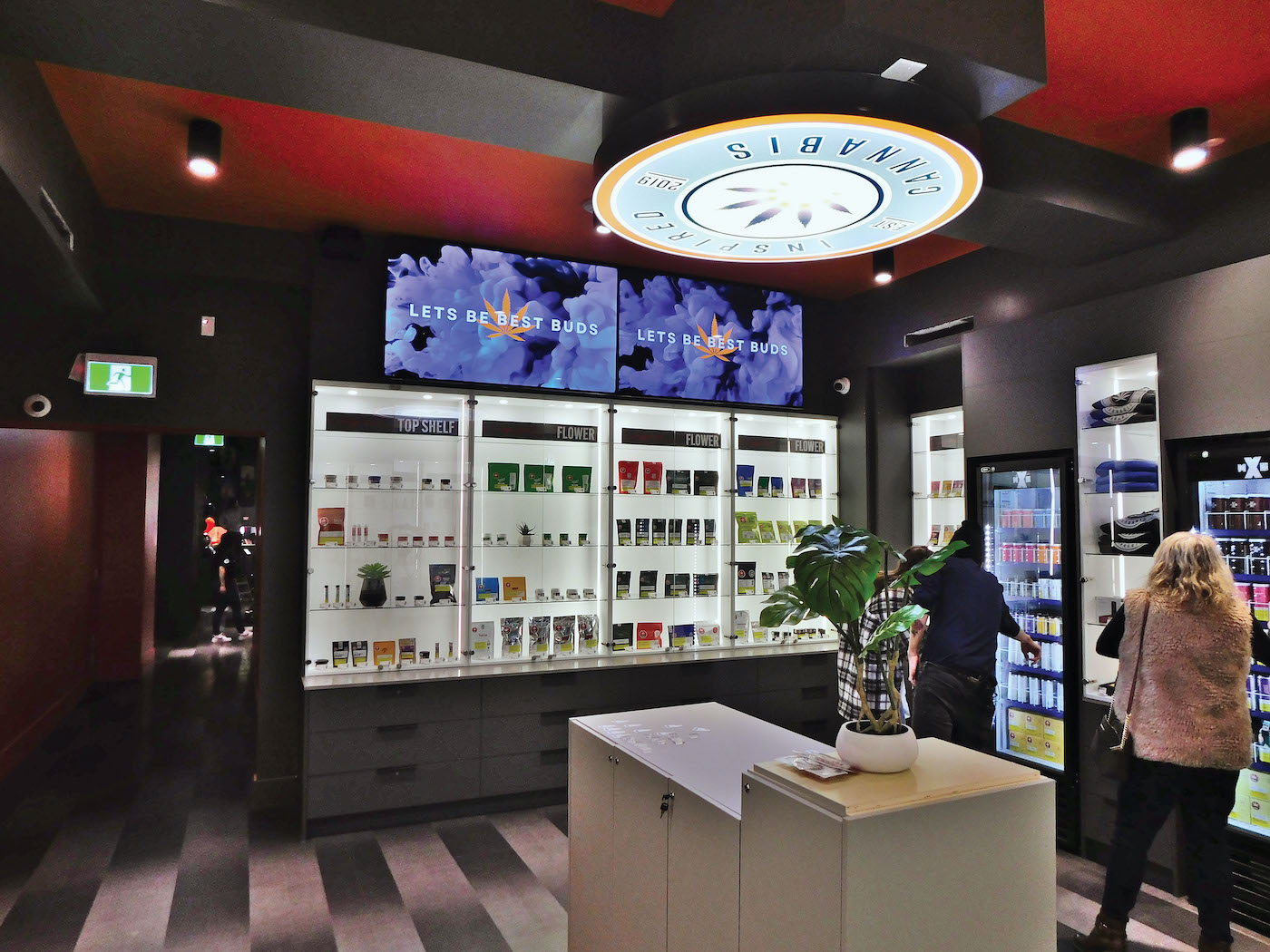The rise of honest-to-goodness brands has ushered in incredible improvements for numerous stakeholders throughout the cannabis industry. Brand differentiation helped producers set themselves apart, consumers gained more confidence in the integrity of their purchases, and dispensaries got an influx of diverse, visually arresting products to put on their once-barren shelves.
Today, some of the coolest stores in North America place brands at the heart of the shopping experience. Using traditional retail methods like shelf-space buys, shops-in-shops, and endcaps, dispensary owners are leveraging brands’ increasingly high-quality creative to bring their stores to life.
One store taking the notion of the branded retail experience to another level is Inspired Cannabis’s downtown Vancouver store, dubbed House of Brands. Inspired is one of Canada’s leading dispensary chains, and the company’s latest spot in the bustling Robson Street commercial corridor gives some of the country’s hottest brands the chance to circumvent onerous packaging requirements and showcase their products more freely.
“There was nothing out there that was really about the brands,” said Inspired Cannabis co-founder and president Jesse Dhami. “All the other stores were offering the highest THC at the lowest price. We saw a gap in the market to celebrate great brands the same way liquor stores do.”
Dhami founded the company in 2019 with his business partner Serge Biln, and they quickly—and somewhat spontaneously—built their budding empire to fifteen stores across British Columbia, Ontario, and Saskatchewan.
House of Brands, which Dhami considers Inspired’s flagship store, was a couple years in the making. The 2,400-square-foot space on Robson Street was highly desirable given the historic shopping street sees around 50,000 visitors daily, and many of them are tourists or residents venturing in from Vancouver’s suburbs.
From a design perspective, it’s not a stretch to say House of Brands is among the more novel and forward-thinking stores in the industry. Designed to feel like a gallery or museum, the space is compartmentalized and intended for exploration, perusal, and contemplation within a guided customer journey.
Dhami’s background in real-estate development, specifically luxury homes, informed a fundamental spatial sensibility for House of Brands. “We set out to design a space that took people on a journey through dedicated sections where the brands could shine,” he said.

His team specifically looked to iconic retailer Nordstrom and its much-emulated shop-in-shop kiosks as a point of inspiration. Dhami aimed to cultivate an equivalent browsing experience that placed an emphasis on educating consumers about brands and yielded a better customer experience. “We aimed for a Nordstrom-like model that would work in this space but wouldn’t impact the customer journey and would allow them to flow through this gallery and get a true sense of the brands,” he said.
Customers enter from the bustling street and snake through the space, passing wall decals and shelf build-outs from some of the trendiest, most creative companies in Canada. Laid out like a modern art gallery with installations, modules, floor-to-ceiling displays, and little windowed shelving units showcasing various products, every inch of the space pays homage to a brand.

“When we did this, we didn’t know if the brands would take to it,” Dhami said. “But we got all the sections allocated within two weeks, and we currently have a waitlist of brands wanting to get in.”
Dhami believes the stringent advertising limitations placed on Canadian companies have created a need for concepts like House of Brands, which not only places brands at the center of the experience but also gives them space to shine. “You can’t advertise like traditional [consumer-packaged-goods] brands, so how do you get your name out there? You do that with stores like this in tourist areas,” he said.
Anecdotal evidence from Inspired Cannabis stores and their brand partners suggests the model is having an impact nationwide. “We’ve heard countless stories about people coming into our stores, talking to our budtenders, and then going back to their local store to pick up the products they otherwise might not have learned about,” Dhami said.
After customers have made it through the gallery, they come to a more traditional store area with a broader variety of SKUs. Inspired Cannabis buys centrally for all its stores, although each is stocked differently. On the whole, Dhami considers the franchise to be highly curatorial.

“We’re always selective, but we’re even more so at this store,” he said. “One thing we’ve found across the country is stores put way too much product in categories. I see some stores with eighty pre-rolls! How can a budtender know all of that product and reasonably make a recommendation?”
Having knowledgeable budtenders who place considerable emphasis on the customer experience is essential to Inspired’s success, especially at House of Brands. The company did away with cash registers, following Apple’s lead and pairing customers with cashiers who manage the transaction more intimately.
“We’re high-touch,” Dhami explained. “We’re not transactional. We don’t even have a menu. When you go through the journey with the budtender, you’re looking at products and asking questions. It’s all very much tailored to the customer.”
Despite the commercial advantages and the Inspired team’s evident passion for innovation, Dhami is staunch in his belief dispensary owners should never lose sight of the basics, particularly as competition heats up. For him, customer loyalty resides at the nexus of price and experience.
He recounted an episode when he bought a $75 product from one store only to find the exact same product five minutes down the street at a different store for $59. “We would never gouge the customer,” he said. “Providing cannabis at an affordable price is really important to us. If we can deliver an exceptional level of service and prices are low, we’ll keep that customer. It’s pretty simple.”
Like many other entrepreneurs, Dhami and his team are driven by a mission larger than themselves. They see retailers playing a vital yet humble role in the supply chain, acting as facilitators between customers and brands. It’s this pursuit they feel is vital for the positive evolution of the industry.
“It’s important for retailers to remember we’re not the stars. There are a lot of people who grow great weed and create awesome brands. They’re the stars,” said Dhami. “For me, helping consumers develop brand recognition is extremely important.”
Photos: Ramtin Haj












